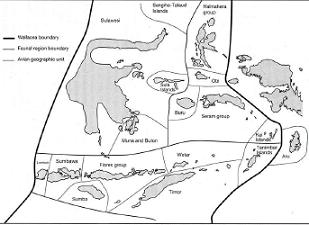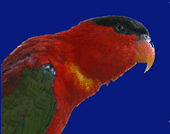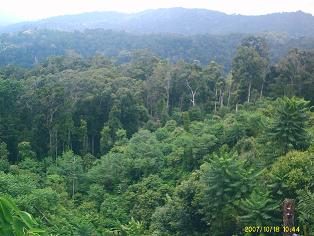
 |
|
|
|---|
| The 10 biounits in Nusa Tenggara and Maluku combined are biodiversity centers. However, within these units there are habitats and biotic assemblages that are of special interest. |
 |
|---|

The island of Halmahera retains a particularly important assemblage of birds and likely also of all other biotic groups. Komodo National Park for its viable population of Komodo Dragons and for the reefs and their biota that surround Komodo and its associated islands.
Protected Area Coverage
Although Nusa Tenggara and Maluku have numerous and extensive protected areas, more than half of these remain ungazetted. Few reserves have been gazetted in the most endangered habitats, the Lowland Rainforests, which are the richest habitats for biodiversity in these regions. For example, 31 endemic birds and almost all mammals are associated with lowland forests in Sumbawa (Jepson and Monk 1995).
In Nusa Tenggara, three biounits have been proposed (see earlier sections of this Report). These include Sumba only; Flores (Lombok, Sumbawa through to Alor) and Timor (Wetar and surrounding islands). Maluku has seven biounits: Halmahera (Moratai, Halmahera, Bacan, Obi, and smaller islands)- it is the richest group for biodiversity – Sula islands; Buru; Seram/Ambon group; Kai Islands; Aru Islands and Banda group (MacKinnon and Artha 1981). It is important that each of these biounits individually is well represented by protected areas.
The national parks in the region are as follows:
Gunung Rinjani National Park (41,330 ha) a landscape scale area from the Montane Forests through to lowland forests and savanna.
Komodo National Park (173,300 ha) for its reefs and associated biota. It is both a UNESCO Natural World Heritage Site and a Biosphere Reserve.
Manupeu – Tanah Daru National Park (87,984 ha). It is some of the last remaining Monsoon Forests in Sumba. Mostly it is sharply rising hills from sea level to 600 m. It contains 118 species of plant, 87 species of bird and 57 species of butterfly.
Laiwangi – Wanggameti National Park (47,014 ha), represents all forest types in Sumba. It is particularly important for the bird assemblage that it contains.
Kelimutu National Park (5,000 ha) provides habitat for 19 restricted range bird species and four endemic species of mammal.
Manusela National Park (189,000 ha) is a landscape scale park that comprises Coastal Forest (including mangroves), swamp forest, Lowland Rainforest, Montane Rainforestand Sub-alpine Forests. It is the quintessentially important protected area in the Maluku as exemplified by its 117 species of bird (14 endemic).

Many of the proposed reserves are located at lower altitudes. However, the main purpose of most of the is recreational, except for reserves in the Aru islands and the Banda Sea which are mainly strict nature reserves and wildlife sanctuary reserves. For the Flores biounit, many of the reserves are purely recreational parks, and many at lower altitudes have been promoted to attract tourism and so offer less protection than previously. Consequently, it is concluded that there is inadequate protected areas, both by designation, location, purpose to adequately represent the biodiversity in each of Nusa Tenggara and Maluku biounits. |
|---|
Source : Report on Biodiversity and Tropical Forests in Indonesia, USAID/Indonesia, 2004. Prepared by : (1) Steve Rhee, M.E.Sc. (2) Darrell Kitchener, Ph.D. (3) Tim Brown, Ph.D. (4) Reed Merrill, M.Sc. (5) Russ Dilts, Ph.D. (6) Stacey Tighe, Ph.D. |
 |
 |
|---|
|
|||||||||||||||||||||||||||
|---|---|---|---|---|---|---|---|---|---|---|---|---|---|---|---|---|---|---|---|---|---|---|---|---|---|---|---|
|
|
|||||||||||||||||||||||||||